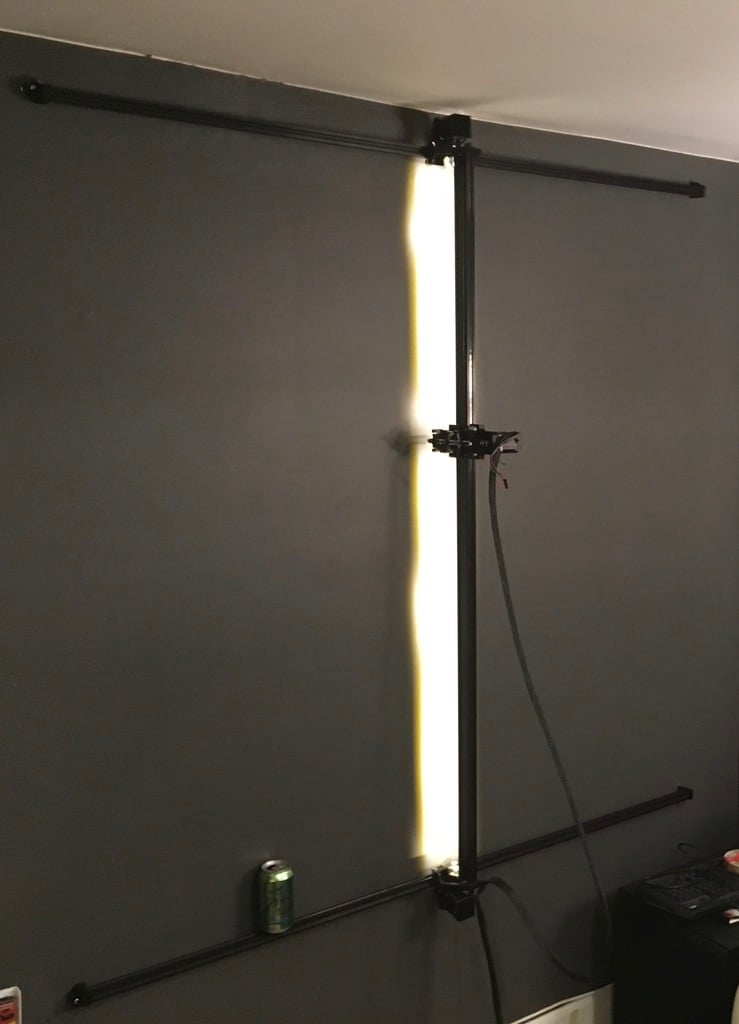
Wall Mount Drawbot
thingiverse
I designed this after seeing other drawbots and wanting something I could hang on the wall and create large scale prints with. This machine can be run from many different controllers, but I am using an Arduino with a CNC Shield and a grbl fork with servo support much like the other drawbots and many of the grbl settings are similar. I plan on replacing the Arduino and shield with a Duet board for better results. https://github.com/robottini/grbl-servo I printed most parts in PETG 100% infill with 0.20 layer heights and supports where needed. This uses V-slot rail and wheels from Openbuilds. http://openbuildspartstore.com/v-slot-linear-rail-1/ http://openbuildspartstore.com/xtreme-mini-v-wheel-kit/ The Y Axis is 20x40 and the X Axis is 20x20. The belts are all run through the rail channels, and it even has placement to hide the stepper wires and run a strip of LEDs along either axis. I used a SG90 servo to move the pen and these steppers. https://www.amazon.com/Stepper-Motor-Bipolar-64oz-Printer/dp/B00PNEQI7W Using 24V and good quality stepper drivers is really necessary for the motor torque to pull the carriages along. I have used direct cooling on the board and heatsinks to keep the motors cooler. Bolt sizes vary from M3 to M5 at all different lengths, but are primarily flat head or hex. One thing I will express is that the spring that tensions the pen to the wall needs to be very weak, just strong enough to press the pen to the paper and distribute ink. The carriage that holds the pen is mounted on 3mm X 80mm rods, and the holes will need to be opened slightly to achieve smooth movement with such a weak spring. Use caution when expanding the holes as an additional movement in that carriage will cause quality to decline rapidly. I recommend using the rods to expand the holes slightly by gently rocking in a circular motion with only a small portion of the rod in each hole, do not over expand. Once it's close, run the servo up and down a few hundred times to smooth everything out. PTFE grease may be a good way to get very smooth movement, but I have not tried it. Quality and speed are all very good. I have attached an image of a space filling curve my 1000x1000mm machine did at decent speed. I am sure this deserves a better write-up than I am giving at the moment, but I will do a more detailed one in the near future. Parts marked XL space the machine farther from the wall to fit most thin stretched canvases. Some of the parts need to be rotated before printing, and I will fix that in the next upload. Edit: I have since upgraded to a Duet Wifi board with great results. Stepper motors were upgraded to the 0.9 degree variant. The servo is much easier to setup and control; I will likely upgrade to a higher quality servo. The stepper motors all run incredibly smooth at 16th step with interpolation at good speeds. I have Nema dampeners on the steppers, and plan on replacing the current Duet driver fan with a Noctua and the thing will be almost completely silent. Write up coming soon.
With this file you will be able to print Wall Mount Drawbot with your 3D printer. Click on the button and save the file on your computer to work, edit or customize your design. You can also find more 3D designs for printers on Wall Mount Drawbot.
